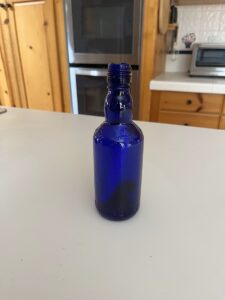TRURO — Fred Marshall was out hunting for sea glass on Cobb Hill Beach on April 16 when he thought he spotted treasure: a glint of cobalt blue — the most coveted color of sea glass — peeking out from the matte sand.
But the blue wasn’t coming from a weathered chip of glass. It was an entire bottle, perfectly intact and nestled on the shore above the descending tide.
He brought the bottle back to his house in South Truro, where he held it up to the light. There was something inside. “I could see that there was a piece of paper all rolled up,” Marshall said.

With pliers, he extracted the paper from the bottle. It was a handwritten note, penned neatly in teal marker. “Hey sissy,” the note read. “I can’t believe you’re gone.”
The letter was dated Oct. 12, 2022. It had been written by a 41-year-old woman named Jennie Barnes as a farewell to her twin sister, who had died the previous May. The letter chronicled the sisters’ relationship, how they were separated at five, when they were placed in foster care, and how they saw each other only a few times after that. “You were my twin,” Barnes wrote, and “I never truly knew you.”
At the end of the letter, Barnes added: “You always wanted to travel, so I’m throwing this bottle in the ocean, and maybe it will end up somewhere cool.” She added her phone number.
Marshall called the number and, after a couple of rings, a woman picked up. “Jennie?” he began, “I found your bottle.”
Barnes asked Marshall where he was. He told her he found the bottle in Truro, Mass., “which I could tell meant nothing to her,” he said. She told him she was in Portland, Ore.
According to Barnes, she had gone to Lincoln City, Ore. with her boyfriend to cast the bottle into the sea. “I didn’t know how else to say goodbye,” Barnes said.
Barnes placed a memento in the bottle along with the letter — a small red velvet heart her sister had made. She dipped the corked top in wax 20 times to seal it, she said, then placed it in the ocean.
The Independent asked Amy Bower, a senior scientist at the Woods Hole Oceanographic Institution (WHOI), what the bottle’s trajectory might have been. Bower, who specializes in large-scale ocean currents, said the idea that it traveled by sea from Oregon to Massachusetts in six months is “basically an impossibility.”
Doing quick math, Bower calculated that the bottle would have had to travel 50 kilometers a day to reach Truro in six months. “That’s a pretty strong current,” she said, though “not the strongest.” The Gulf Stream she said, runs 200 kilometers a day.
But even that’s assuming a direct current from Oregon to Massachusetts, and it turns out there’s no such thing. “There is an incredible network of ocean surface currents around the globe,” Bower said. “There isn’t a simple connected current that could have taken any drifting object from the West to the East Coast.” The bottle would have either gone through the Panama Canal or around Cape Horn at the tip of South America. For that to happen in six months is pretty much out of the question.
A current off the coast of California goes south only as far as Mexico, Bower said, and then it diverges west into the Pacific. “It would go way out into the Pacific for months and months, and then maybe it would come back with another current further south towards Central America. But that would be months also,” Bower said. And on the East Coast, the Gulf Stream could have taken the bottle directly north, but Bower said that current is still over 300 miles away from Cape Cod.
Bower had another idea: perhaps the bottle had been sucked into the ballast of a cargo ship, which takes on water to stabilize the boat before it is loaded with cargo, and then was spit back out near Massachusetts, essentially “taking a piggyback ride with the ship,” Bower said.
But according to Eric Benway, a port captain at WHOI, “it is just as unlikely it hitched a ride via a ballast of tank water. Ballast systems on vessels require all sea water to go through various pumps when being sucked into and out of a ship. These pumps are very high pressure, and if anything found its way in there, it would have been broken into bits.”
Bower added that the fact that the bottle was in pristine condition when Marshall found it “is a pretty big clue,” she said. “If it had been in the ocean for a long time, it would be covered with seaweed and barnacles.”
She said a likelier possibility is that someone found the bottle on the West Coast, then brought it on a trip to Truro, or nearby, and dropped the bottle back into the water. The scientist sympathized with an M.I.B. finder: “That would be disappointing,” Bower said.
Marshall said that when he found the bottle there was no wax sealing the top, which led him to believe someone must have found it before he did and melted the wax off to read the letter.
“Maybe I will never know,” said Marshall. But of this he is certain: the woman he reached on the phone that April afternoon was Jennie Barnes. “When I pulled the note out of the bottle, I saw that there was something else at the bottom,” Marshall said.
“When I called Jennie, she said, ‘So you’ve got the message in my bottle,’ and I said, ‘Yes.’ Then she said, ‘Then you’ve got my heart.’ ”
